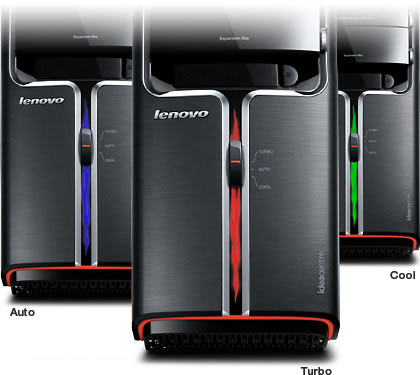Impressions and Conclusion
Intel's second-gen i7-2600 is one of the top performing processors available today and serves as a great foundation for a gaming rig – in fact, we recommend the K series i7-2600 in our Luxury System guide. Our test unit came equipped with 12GB of DDR3 which seems a bit excessive as 8GB is likely the most I would install in my own gaming rig if I were to build one. Granted, memory prices are dirt cheap these days, but I think that money could be better allocated in our $1,099 configuration.
Gaming performance from the GTX 460 was respectable, despite being a year-old mainstream card. There is room for additional graphics horsepower if desired as the microATX motherboard allows for SLI or CrossFireX setups, which can be purchased directly from Lenovo or configured on your own. Be aware that a high-end dual-card configuration will likely require you to upgrade the power supply as well. Instead we'd have preferred to have an alternate, more powerful single-GPU graphics card option to choose from Lenovo, but that's not the case at this point.
A maximum system power draw of 299 watts was measured on the system as configured with the single GTX 460. This is a worst-case scenario as I used OCCT's power supply stress test and Prime 95 simultaneously to generate a synthetic maximum load. For reference, we tested two GTX 460s in SLI last year and noted a load power draw of 447 watts on an overclocked Core i7-920 machine.

The K330 with two GTX 460s wouldn't draw quite that much power, but it'd still be taxing if not impossible for the stock power supply to withstand the demand. Additionally there isn't an extra 6-pin PCI-e connector on the power supply so you would need a Molex adapter to power the second graphics card.
Along with measuring power draw, I also measured system temperatures both at idle and full load. The room temperature was kept at a steady 23.8C during these tests. The idle CPU temperature was 32C while the idle GPU temperature reached 31C. Under full system load, the CPU leveled out at 76C and the GPU settled at 80C.
Surprisingly enough, although the system was audible at full load, it wasn't nearly as loud as I anticipated. I think this has a lot to do with the reference GPU cooler's design as it dumps hot air directly out of the case rather than circulating it inside the system, which would likely cause other fans to kick into overdrive. Fan noise during normal system use was very quiet and hardly audible at all.
The Blu-ray drive and 16-in-1 card reader are nice additions to this system and help round things out. One key connectivity option missing, however, is USB 3.0.

Hard drive performance fell in line with what we'd expect. The key selling point here is the 2TB of storage – not necessarily speed. If you're looking for a performance-minded setup, Lenovo also offers RAID configurations. If you intend to house your operating system on a solid-state drive, you'll have to purchase this elsewhere, and that's probably for the best (the odds of Lenovo stocking precisely what you want are slim).
As mentioned earlier, the included mouse and keyboard will get the job done for most common tasks, but heavy gamers will want to spring for some aftermarket peripherals for their added functionality.
Overall the Lenovo K330 is a very capable desktop for most users, although I think it could use a tiny bit more GPU horsepower to live up to the "gaming central" moniker that Lenovo has branded it with. Until a few weeks ago the same system was being sold for $1399, which was definitely not worth considering, but at $1099 the IdeaCentre K330 offers a good mix of hardware that is in line with what other PC makers like Dell are selling for the same price.
There are some obvious differences between the K330 and what we recommend in our Enthusiast's PC buying guide which currently details a build for $1200. Our build has no OS, 4GB less RAM and less storage, but it's overclocking-friendly thanks to the K series processor, features a faster video card, and we like to include a small SSD for multitasking performance. That's on top of the quality aftermarket power supply, sound card and chassis. The power supply and case will have no problem accommodating additional video cards should you choose that route.
This is assuming you have the time and know-how to build your own computer, which can't be said for everyone. With all the overpriced, over-hyped junk we see in the retail desktop market, such individuals could certainly do well looking into Lenovo's K330 desktop.